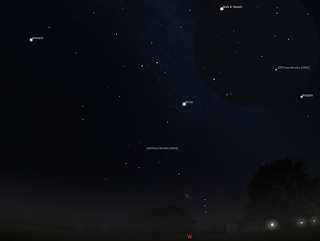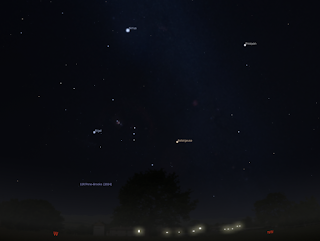Tuesday, May 28, 2024
Thursday May 30 to Thursday June 6
The last Quarter Moon is Friday, May 31. Comet 12P Pons-Brooks is visible when the sky is fully dark but remains a binocular only object. The comet leave the iconic Orion constellation behind and moves into Canis Major. In the morning the Moon moves down the lineup of Saturn, Mars and Mercury. Despite claims of a rare alignment of planets being visible to the unaided eye on June 3, the actual alignment on June 5 will be difficult to see.
The last Quarter Moon is Friday, May 31. The Moon is at perigee, when it is closet to earth, on June 2.
The comet has faded to magnitude 6, and you need binoculars. With the Moon rising out of the way the comet is easier to see now. Over the week the comet will climb higher into darker skies heading towards Canis Major. Updated spotters charts are here.
Similar views will be seen from the rest of Australia at the equivalent local time (90 minutes after sunset).
Elsewhere in Australia will see a similar view at the equivalent time (90 minutes after sunset).
Mercury sinks into the twilight and is soon lost to view. Mercury and Jupiter are close on the 5th.
Venus is lost in the morning twilight.
Mars is rising in the morning twilight. Mars is close to the crescent Moon on the 3rd.
Jupiter returns to the the morning twilight sky. Mercury and Jupiter are close on the 5th.
Saturn climbs higher in the morning twilight. Saturn is close to the crescent Moon on the 1st.
Star Map via Virtual sky. Use your mouse to scroll around and press 8 when your pointer is in the map to set to the current time.
Cloud cover predictions can be found at SkippySky.
Here is the near-real time satellite view of the clouds (day and night) http://satview.bom.gov.au/
Labels: weekly sky
Tuesday, May 21, 2024
Thursday May 23 to Thursday May 30
The Full Moon is Thursday, May 23. Comet 12P Pons-Brooks is now visible when the sky is fully dark but remains a binocular only object. The comet starts the week close to the iconic Orion constellation and is within a binocular field of the bright star Rigel. As the Moon passes from the evening sky the comet becomes easier to see. In the morning the lineup of Saturn, Mars and Mercury makes for nice viewing. By the end of the week the waning Moon joins the lineup.
The Full Moon is Thursday, May 23.
Evening sky on Thursday, May 23 as seen from Adelaide at 18:44 ACST (90 minutes after sunset, click to embiggen). Comet 12P is now beside Orion when the sky is fully dark.While
the comet is a reasonable magnitude 5.5, you will still need
binoculars. Especially with the Full Moon making it harder to see. Nonetheless the binocular view with the comet near Orion's belt is nice.
Over the week the comet will climb higher into darker skies past the bright stars of Orion towards the constellation of Lepus the hare. Updated spotters charts are here.
Similar views will be seen from the rest of Australia at the equivalent local time (90 minutes after sunset).
The comet has faded to magnitude 6, and you need binoculars. With the waning Moon rising later the comet is easier to see now. Over the week the comet will climb higher into darker skies coming closer to the bright star Arneb. Updated spotters charts are here.
Similar views will be seen from the rest of Australia at the equivalent local time (90 minutes after sunset).
Elsewhere in Australia will see a similar view at the equivalent time (90 minutes after sunset).
Mercury begins to sink into the twilight but still remains bright in the morning twilight.
Venus is lost in the morning twilight.
Mars is rising in the morning twilight.
Jupiter is lost in the twilight sky.
Saturn climbs higher in the morning twilight.
Star Map via Virtual sky. Use your mouse to scroll around and press 8 when your pointer is in the map to set to the current time.
Cloud cover predictions can be found at SkippySky.
Here is the near-real time satellite view of the clouds (day and night) http://satview.bom.gov.au/
Labels: weekly sky
Tuesday, May 14, 2024
Thursday May 16 to Thursday May 23
The Full Moon is Thursday, May 23. Comet 12P Pons-Brooks is now visible when the sky is fully dark but is still a binocular only object. The waxing Moon may make it harder to see. The comet is close to the iconic Orion constellation and is within a binocular field of the bright star Rigel. In the morning the lineup of Saturn, Mars and Mercury makes for nice viewing.
The Full Moon is Thursday, May 23. The Moon is at apogee, when it is furthest from the Earth, on the 18th.
While the comet is a reasonable magnitude 5.5, you will still need binoculars. Especially with he waxing Moon making it harder to see. Over the week the comet will climb higher into darker skies past the bright stars of Orion. but will remain within a binocular field of the bright star Rigel. Updated spotters charts are here.
Similar views will be seen from the rest of Australia at the equivalent local time (90 minutes after sunset).
Elsewhere in Australia will see a similar view at the equivalent time (90 minutes after sunset).
Mercury begins to sink into the twilight.
Venus is lost in the morning twilight.
Mars is rising in the morning twilight.
Jupiter is lost in the twilight sky.
Saturn climbs higher in the morning twilight.
Star Map via Virtual sky. Use your mouse to scroll around and press 8 when your pointer is in the map to set to the current time.
Cloud cover predictions can be found at SkippySky.
Here is the near-real time satellite view of the clouds (day and night) http://satview.bom.gov.au/
Labels: weekly sky
Monday, May 06, 2024
Thursday May 9 to Thursday May 16
The First Quarter Moon is Wednesday, May 15. Comet 12P Pons-Brooks is now visible when the sky is fully dark but is still a binocular only object. The comet will progressively climb higher and is near the iconic Orion constellation. In the morning the lineup of Saturn, Mars and Mercury makes for nice viewing.
The First Quarter Moon is Wednesday, May 15.
While the comet is a modestly bright magnitude 5, despite now being visible when the sky is fully dark, you will still need binoculars. Over the week the comet will climb towards Orion and into darker skies, but becomes dimmer as it rises. Updated spotters charts are here.
Similar views will be seen from the rest of Australia at the equivalent local time (90 minutes after sunset).
Evening sky on Thursday, May 16 as seen from Adelaide at 18:52 ACST (90 minutes after sunset, click to embiggen). Comet 12P is now just below Orion when the sky is fully dark. The inset shows the binocular view at this time.While the comet is a reasonable bright magnitude 5.4, you will still need binoculars. Over the week the comet will climb higher into darker skies and closer to the bright stars of Orion. Updated spotters charts are here.
Similar views will be seen from the rest of Australia at the equivalent local time (90 minutes after sunset).
Elsewhere in Australia will see a similar view at the equivalent time (90 minutes after sunset).
Mercury begins to sink into the twilight.
Venus is lost in the morning twilight.
Mars is rising in the morning twilight.
Jupiter is lost in the twilight sky.
Saturn climbs higher in the morning twilight.
Star Map via Virtual sky. Use your mouse to scroll around and press 8 when your pointer is in the map to set to the current time.
Cloud cover predictions can be found at SkippySky.
Here is the near-real time satellite view of the clouds (day and night) http://satview.bom.gov.au/
Labels: weekly sky
Wednesday, May 01, 2024
Thursday May 2 to Thursday May 9
The New Moon is Wednesday, May 8. Comet 12P Pons-Brooks is visible in binoculars and will progressively climb higher over the week heading for the iconic Orion constellation. Between 3 and 6 May the waning Moon joins the lineup of Saturn, Mars and Mercury. On the 4th there is a spectacular close approach of the Moon to Saturn, with a daytime occultation in the eastern states. On the 5th The Moon is close to Mars and on the 6th it is close to Mercury. On the 6th-8th the eta Aquariid meteor shower is visible in the morning sky.
The New Moon is Wednesday, May 8. The Moon is at perigee, when it is closest to Earth, on the 6th.
Evening sky on Saturday, May 4 as seen from Adelaide at 18:27 ACST (60 minutes after sunset, click to embiggen). Comet 12P is rising higher in the evening twilight.While the comet is a reasonable bright magnitude 4.7, it is still not too far from the horizon. You will definitely need binoculars. Over the week the comet will climb higher into darker skies and. Updated spotters charts are here.
Similar views will be seen from the rest of Australia at the equivalent local time (60 minutes after sunset).
While the comet is a modestly bright magnitude 5, despite now being visible when the sky is fully dark, you will still need binoculars. Over the week the comet will climb towards Orion and into darker skies, but becomes dimmer as it rises. Updated spotters charts are here.
Similar views will be seen from the rest of Australia at the equivalent local time (90 minutes after sunset).
Morning sky on Saturday, May 4 as seen from Adelaide at 05:57ACST, (60 minutes before sunrise, click to embiggen). The Moon is very close to Saturn with Mars and Mercury below. The eastern states see a daytime occultation of Saturn in the morning.
The eta Aquariid meteor shower, which is produced by the debris from Halley’s Comet, will peak on May 6 (strictly speaking May 5, 21UT).
Elsewhere in Australia will see a similar view at the equivalent time (90 minutes after sunset).
Mercury climbs higher into the twilight. On the 6th the Moon is close to Mercury.
Venus is lost in the morning twilight.
Mars is rising in the morning twilight. On the 5th The Moon is close to Mars.
Jupiter is lost in the twilight sky.
Saturn climbs higher in the morning twilight. On the 4th there is a spectacular close approach of the Moon to Saturn, with a daytime occultation in the eastern states.
Star Map via Virtual sky. Use your mouse to scroll around and press 8 when your pointer is in the map to set to the current time.
Cloud cover predictions can be found at SkippySky.
Here is the near-real time satellite view of the clouds (day and night) http://satview.bom.gov.au/
Labels: weekly sky
























 Click to read about or order
Click to read about or order Click to read about or order
Click to read about or order Click to read about or order
Click to read about or order Click to read about or order
Click to read about or order




